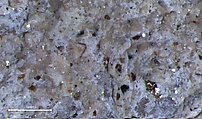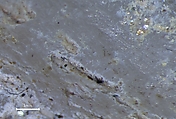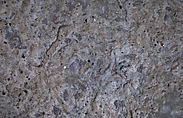On loan to The Met The Met accepts temporary loans of art both for short-term exhibitions and for long-term display in its galleries.
Marble female figure
Technical analysis: Multiband imaging, optical microscopy, X-ray fluorescence spectroscopy, Raman spectroscopy
The piece is intact except for a join in the upper neck and a few small modern fills which have been repaired. There are encrustations covering the entire figure, some of which have been removed, especially in the area of the neck and lower back legs. There is no evidence of pigment or paint "ghosts." The head is spade shaped with a prominent nose, the mouth indicated by a shallow groove. The head rests on a tall, massive neck, which is decorated with a series of grooves – six on the front and eight on the back. The broad carefully sloped shoulders come to right corners that become the narrow arms which are bent at the elbows and rest the left upon the right to frame the upper body. Small, rounded breasts, the left slightly smaller than the right, are spread far apart on the otherwise flat chest. Beneath the arms, the belly consists of three horizontal bands that may indicate post-partum folds of flesh. A prominent pubic triangle and genitals are defined by three grooves, the central one continuing to create the division between the legs down to splayed feet. On the back, a single vertical line is used to indicate the spine, the cleft between the buttocks and the division of the legs to the feet. The lower engraved line on the back and on the front are not straight but free form in contrast to the highly organized and carefully executed schema of the rest of the figure.
Among the most contentious pieces in the Leonard N. Stern Collection, the authenticity of this work is particularly open to debate with strong arguments for and against. It is clearly the product of a talented artist whose work shares strong affinities with sculptures attributed to an ancient Cycladic sculptor known as the Dresden Master, so named after a work in the Dresden Museum. It also exhibits unusual features, most notably its fine state of preservation, exceptionally large size for the Chalandriani type, and the unparalleled series of bands carved into the neck. It is said to have been acquired in the 1920s by Joseph Weller, a prominent German businessman who is known to have collected antiquities, especially bronzes. However, there is no documentation to support this assertion. The calcareous accretion embedding abundant biotite flakes and the fibrous and fine botryoidal accretions on the back of the sculpture are unusual as well and would deserve further in-depth analysis to determine if they may have been artificially applied in modern times, or if they may be associated to a particular burial or geological context in the Cyclades.
Seán Hemingway, Dorothy Abramitis, Federico Carò
Due to rights restrictions, this image cannot be enlarged, viewed at full screen, or downloaded.
This artwork is meant to be viewed from right to left. Scroll left to view more.











